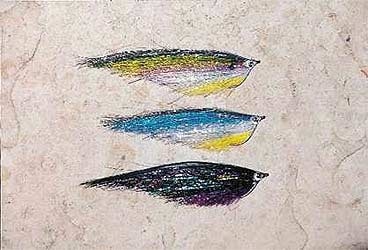
Many creative fly tiers such as Lefty Kreh, Bob Clouser, Bob Popovics and others have treated us with some classic fish-catching flies. Their flies, like the Lefty’s Deceiver, Clouser Minnow and Popovics’ Surf Candy, will catch fish around the world. However, like many of our flies of today, they mostly imitate slender baitfish. Many wider-profile baits such as bunker and herring present a challenge to the fly tier to imitate effectively, and to the fly fisherman to cast with the long rod. Until now.Living and guiding in the Sandy Hook region of the Raritan Bay in New Jersey, I am blessed with an abundance of baitfish called bunker. Our bunker vary year to year from schools of large 1- and 2-pound bunker to years like our most recent, in which we were blessed with acres of 3- to 5-inch peanut bunker. I have spent almost seven years studying bunker and tying flies to represent them. During that time we’ve fished many bunker patterns with success. Sedotti’s Slammer, Tabory’s Slab Side and even my own Bozo Bunker have all caught fish and represented huge steps toward the perfect wide-profile fly. But the wider profile is not enough.Bunker and other wider-profile baitfish constantly flash by rolling or flipping their bodies sideways. You will easily notice these flashes the first time a school of bunker happens by. So to effectively imitate bunker, the fly needs to also provide the flipping action that so many great plugs and lures impart.To properly tie a wide-profile pattern that wasn’t a wet sock to cast, I had to come up with a new style of tying. That style is is something we call the vertical tie, and the result of our efforts is a fly called the Wide Side. The vertical tying method uses multiple layers of material and flash tied up the hook to combine flash into the body itself. This provides an incredible look in the water and prevents the fly from collapsing. The result is a wider-profile fly with no bulk. The Wide Side is easy to construct, but take caution to use less material in more layers for this fly. The secret to this fly is the design and not excessive material. Also, I have found it critical to use Kinkyfibre from Success Flies for the body of this fly, as this synthetic material gives bulk without absorbing water. The circle hooks are great to tie on, but don’t be fooled by the sizing on these hooks. They tend to run about one size smaller than the hooks you are currently tying on. I recommend using a slightly larger size than normal – somewhere between 3/0 to 6/0. While retrieving the Wide Side you will notice the little flip or flash the fly gives you at the end of each strip that is so essential in triggering the strike from a stalking fish. The offset hook that I suggest enhances that action, since the body of the fly lies on one side of the hook point. Also, you can control the flipping action by adjusting the speed of your retrieve and the tempo at the end of each strip. In fast-moving water, you may wish to simply hold the line and barely move it while the Wide Side takes care of the rest – the current and taut line will give all the action you need. In slower water, strip as you would normally, playing with the end of each individual strip to find the amount of flash that looks right for the situation.









